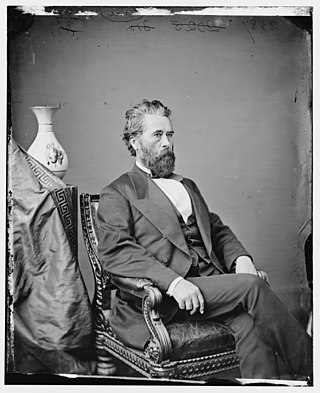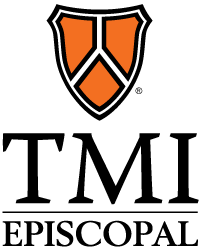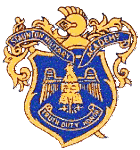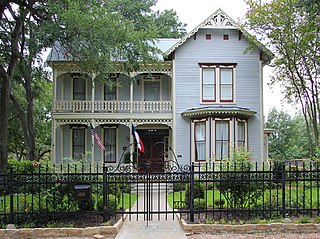
"Diagonal Street" is now Church Street
Allen-Fowler House in foreground.
Bastrop Academy, later renamed Bastrop Military Institute, was located in Bastrop, Texas. The institute was moved to Austin in 1870 and renamed to Texas Military Institute. [1]

Bastrop Academy, later renamed Bastrop Military Institute, was located in Bastrop, Texas. The institute was moved to Austin in 1870 and renamed to Texas Military Institute. [1]
In 1851, the citizens of Bastrop, in the form of the Bastrop Educational Society, founded the Bastrop Academy, and the school received its charter on January 24, 1852. Professor William J. Hancock of Aberdeen, Mississippi became the first headmaster at the academy, and the Bastrop Female Academy was incorporated. On arrival, Hancock built what is now referred to as the Allen-Fowler House at 1404 Wilson Street, [2] [3] not only for him and his family, but also for student boarders.
Bastrop Academy was rechartered on February 7, 1853, under the jurisdiction of the Methodist Episcopal Church, South. Administrators built a two-story pine building for $15,000; it had separate male and female study halls and a library of 1,000 volumes. The enrollment was 132 for the first session and increased to 194 by 1857. The academy became one of the leading schools in Texas. [4]
In 1857, the male part of Bastrop Academy became Bastrop Military Institute, which trained young men for service during the Civil War. Colonel Robert Thomas Pritchard Allen replaced Hancock as headmaster and Allen and his wife Julia purchased Fowler House. They continued to board cadets that attended the institute. [2]
During the American Civil War, enrollment at the Bastrop Military Institute a significant decline. Initially, the institute's campus comprised only barracks and recitation halls, proving inadequate for its intended expansion as Texas's primary institution for general and applied sciences. The institute resumed operations in September 1867, albeit with markedly reduced student numbers.
In 1867 John Garland James and his family moved to Bastrop, Texas, where James was president of the Institute in 1868. He was superintendent, business manager, and professor of philosophy and mathematics; his father and brothers, Charles and Fleming Wills James, assisted him in the enterprise. [5] Additionally, James was joined by Hardaway Hunt Dinwiddie in 1868, a fellow alumnus of the Virginia Military Institute (VMI) and a fellow member of the Alpha Tau Omega fraternity.
In the winter of 1869/1870, James and the institute's leadership resolved to relocate the school to Austin, [5] [1] a decision influenced by Austin's recent accumulation of a $10,000 building fund in gold. Subsequently, a 32-acre site was acquired in March 1870. On June 10, 1870, the relocated Texas Military Institute officially commenced operations in its new Austin location. [1]
By 1872, the value of the institute's physical facilities had reached $50,000, including a cadet barracks capable of housing 400 students. The institute's disciplinary approach was inspired by the United States Military Academy at West Point and James' alma mater Virginia Military Institute, encompassing both scientific and literary education. The military component was primarily aimed at physical exercise rather than professional soldier training. Residency in the barracks was mandatory for all cadets. In 1873, the student population stood at 150. The average cost for tuition, board, and other fees amounted to $375 per academic year. The college, while nonsectarian, maintained a religious ethos and operated successfully until 1879. In that year, President John Garland James and the faculty left to join the staff of Texas A&M University. [1]
After the Institute moved to Austin, on May 25, 1872, the City of Bastrop purchased the property of the academy and it became a part of the Bastrop public school system. The city used the buildings for a variety of schools, until a public school system was established in 1892. [6]
In 1876, the headmaster's residence and boarding house was sold to John Preston Fowler and Maud Maynard Fowler. They added Victorian detailing and a projecting bay window to the structure. Fowler became mayor of Bastrop, county attorney and a Texas state senator. [2]

In 1892, the city sold the academy property at 1402 Church Street to Dr. H.P. Luckett, a prominent citizen who had practiced medicine in the town for almost 50 years. Luckett demolished the existing structures, and built the H. P. Luckett House on the site. [4] [6] [7] [8] [9]

Bastrop is a city in Morehouse Parish, Louisiana, United States. It is the parish seat of Morehouse Parish. The population was 9,691 at the 2020 census, down from 11,365 in 2010. The population of Bastrop is 76 percent African American. It is included in the Monroe Metropolitan Statistical Area and is part of the Monroe–Ruston Combined Statistical Area.

Camp Swift is a census-designated place (CDP) in Bastrop County, Texas, United States. The population was 7,943 at the 2020 census. Camp Swift began as a United States Army training base built in 1942. It is named after Major General Eben Swift.

The Virginia Military Institute (VMI) is a public senior military college in Lexington, Virginia. It was founded in 1839 as America's first state military college and is the oldest public senior military college in the United States. In keeping with its founding principles and unlike any other senior military college in the United States, VMI enrolls cadets only and awards bachelor's degrees exclusively. The institute grants degrees in 14 disciplines in engineering, science, and the liberal arts.

The Texas A&M University Corps of Cadets is a student military organization at Texas A&M University. Established with the university in 1876, it is the oldest student organization on campus.

John Hancock was an American judge and politician. As a member of the Texas Legislature he opposed the secession of Texas during the American Civil War. After the war he represented Texas in the United States House of Representatives as a member of the Democratic Party.

TMI Episcopal is a private school in San Antonio. Previously known as Texas Military Institute, TMI is a selective coeducational Episcopal college preparatory school with a military tradition in San Antonio, Texas for boarding and day students. It is the flagship school, and sole secondary school, of the Episcopal Diocese of West Texas. TMI is the oldest Episcopal college preparatory school in the American Southwest. Founded as West Texas School for Boys, the school was later known as West Texas Military Academy, and popularly nicknamed 'West Point on the Rio Grande', though it is several hours from the Rio Grande itself.

Staunton Military Academy was a private all-male military school located in Staunton, Virginia. Founded in 1884, the academy closed in 1976. The school was highly regarded for its academic and military programs, and many notable American political and military leaders are graduates, including Sen. Barry Goldwater, the 1964 Republican presidential candidate, and his son, Rep. Barry Goldwater Jr., 1960's folk singer Phil Ochs, Ramones guitarist Johnny Ramone and John Dean, a White House Counsel who was a central figure in the Watergate scandal of the early 1970s.

The H. P. Luckett House is a Queen Anne style house located in Bastrop, Texas. The 14-room house was built around 1892 for Dr. H.P. Luckett, a prominent citizen who had practiced medicine in the town for almost 50 years. The structure was listed in the National Register of Historic Places on December 22, 1978, and designated a Recorded Texas Historic Landmark in 2011.

Camden Military Academy (CMA) is a private, all-male, military boarding school located in Camden, South Carolina, United States. The State of South Carolina has recognized the institution as the official state military academy of South Carolina. Camden Military Academy accepts male students in grades 7 through 12, also offering a post-graduate year.

The Austin–Round Rock–San Marcos metropolitan statistical area, or Greater Austin, is a five-county metropolitan area in the U.S. state of Texas, as defined by the Office of Management and Budget. The metropolitan area is situated in Central Texas on the western edge of the American South and on the eastern edge of the American Southwest, and borders Greater San Antonio to the south.
Philip Noland Luckett was an American soldier and physician. He served as a general in the Confederate States Army during the American Civil War and was most noted for his service in the Trans-Mississippi Theater. He was influential in convincing a veteran United States Army general to peacefully abandon Federal-held military installations to the Confederacy before the start of the war, providing the fledgling nation with much needed arms and munitions.

Cedar Creek is an unincorporated community in Bastrop County, Texas, United States. It is located about 11 miles (18 km) west of the city of Bastrop. The community takes its name from Cedar Creek, a tributary of the Colorado River that is close to the area. Cedar Creek is home to Bastrop County's inaugural public park and McKinney Roughs Nature Park, featuring both natural landscapes and archaeological sites.

The Fowler House, also known as the Allen-Fowler House is a historic, two-story, modified L-plan house built in 1852 in Bastrop, Texas, United States. The house was added to the National Register of Historic Places on December 22, 1978, and was designated a Recorded Texas Historic Landmark in 2008.

Paige is an unincorporated community in Bastrop County, Texas, United States. Paige has a post office with the ZIP code 78659.
Upton is an unincorporated community in Bastrop County, Texas, United States. According to the Handbook of Texas, the community had a population of 25 in 2000. It is located within the Greater Austin metropolitan area.

Hermann Lungkwitz was a 19th-century German-born Texas romantic landscape artist and photographer whose work became the first pictorial record of the Texas Hill Country.

The Little Campus is a historic district and part of the University of Texas at Austin campus in Austin, Texas. Originally built in 1856 as the Texas Asylum for the Blind, the complex was used for a variety of purposes through the late nineteenth and early twentieth centuries. It was acquired by the University of Texas after World War I and listed on the National Register of Historic Places in 1974.

The history of the University of Texas at Arlington began with the foundation of Arlington College in 1895, which was the first of a series of private schools to exist on the site of the present university. It consisted of first through tenth grades and enrolled between 75 and 150 students on a campus that consisted initially of only a two-story schoolhouse. It was created largely due to the underfunded and generally inadequate public schools in the city. Arlington College closed in July 1902, after Arlington voters passed a proposition to create an independent school district.

Hardaway Hunt Dinwiddie was a distinguished educator and a pivotal figure in the development of Texas higher education. He served as the 4th president of Texas A&M College. He graduated from Virginia Military Institute in 1868. In 1865 while at VMI, he was the second initiate and a charter member of the Alpha Chapter of the Alpha Tau Omega fraternity.

John Garland James was a distinguished educator and a pivotal figure in the development of Texas higher education. He served as the 2nd president of Texas A&M College. He graduated from Virginia Military Institute in 1867. In 1865 while at VMI, he was the first initiate and a charter member of the Alpha Chapter of the Alpha Tau Omega fraternity.